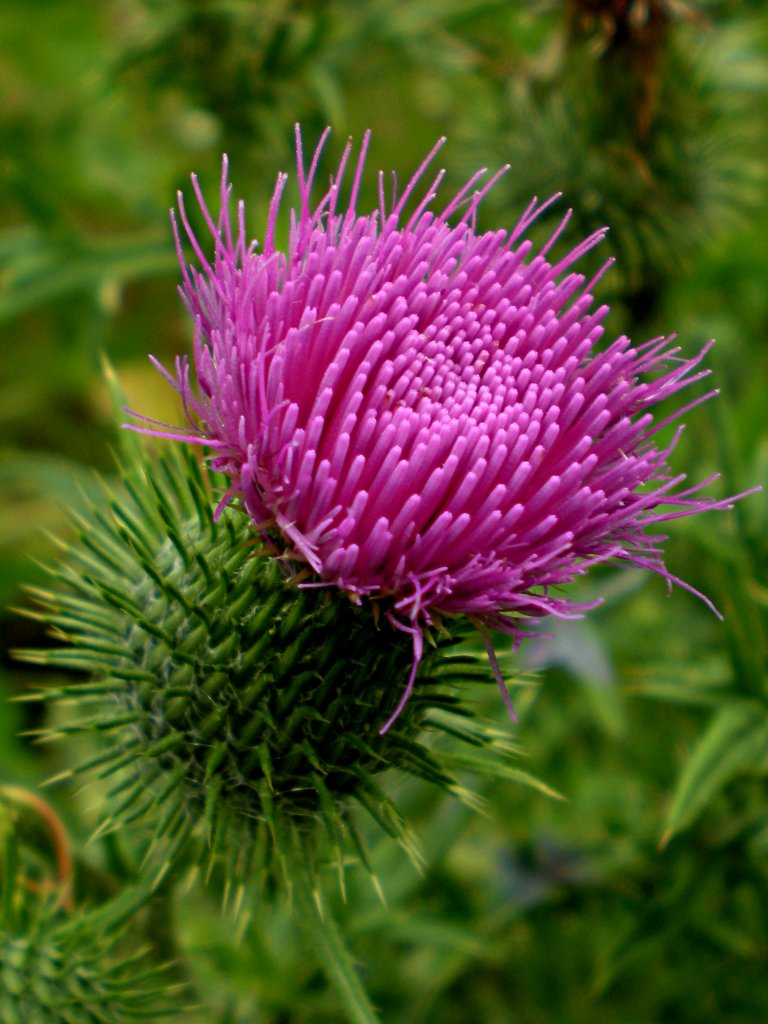This is the big, spiny thistle that always pops up just where you don’t want a thistle. On the other hand, goldfinches love the seeds so much that it’s hard to imagine how the birds survived before Europeans introduced the plant to this continent. Architecturally, the whole plant is very elegant, and the flower heads are superbly artistic, with a tuft of pure magenta erupting from a prickly urn. This plant grew at the edge of a park in Beechview, where it was blooming in the middle of July.
Gray lists this as Cirsium lanceolatum:
CÍRSIUM [Tourn.] Hill. COMMON or PLUMED THISTLE. Heads many-flowered; flowers all tubular, perfect and similar, rarely Imperfectly dioecious. Bracts of the ovoid or spherical involucre imbricated in many rows, tipped with a point or prickle. Receptacle thickly clothed with soft bristles or hairs. Achenes oblong, flattish, not ribbed; pappus of numerous bristles united into a ring at the base, plumose to the middle, deciduous. — Herbs, mostly biennial; the sessile alternate leaves often pinnatifld, prickly. Heads usually large, terminal. Flowers reddish-purple, rarely white or yellowish; in summer. (Name from kirsos, a swelled vein, for which the Thistle was a reputed remedy.) Cnicus of many auth., not L. By some recent Am. auth. included in Carduus.
* Bracts of the involucre all tipped with spreading prickles.
1. C. lanceolatum (L.) Hill. (COMMON or BULL THISTLE.) Leaves decurrent on the stem, forming prickly lobed wings, pinnatifid, rough and bristly above, woolly with deciduous webby hairs beneath, prickly; flowers purple. {Carduus L.;Cnicus Willd.) — Pastures and roadsides. July-Nov. (Nat. from Eu.)
In Wild Flowers East of the Rockies (1910), Chester Albert Reed gives us a good description that turns into an apology for this elegant weed:
COMMON or BULL THISTLE (Cirsium lanceolatum), although an introduced species has a larger range than the last (Cirsium pumilum). It is common in fields and pastures and along roadsides from Newfoundland to Ga. and west to Nebr. Its heads are only slightly smaller than those of the preceding; usually but one is found on a plant. The stout stem grows from 2 to 4 feet high. The leaves are rough and bristly above and woolly underneath.
Although thistles may be foes to those following agricultural callings, they are staunch friends of birds and insects (except crawling ones). The plant fibres and down from the mature heads forms the principal part in the composition of nests of the Goldfinch.
In Wild Flowers Worth Knowing, Neltje Blanchan gives us an apology for all species of thistles:
Common or Plumed Thistle
Cirsium
Is land fulfilling the primal curse because it brings forth thistles? So thinks the farmer, no doubt, but not the goldfinches which daintily feed among the fluffy seeds, nor the bees, nor the “painted lady,” which may be seen in all parts of the world where thistles grow, hovering about the beautiful rose-purple flowers. In the prickly cradle of leaves, the caterpillar of this thistle butterfly weaves a web around its main food store.
When the Danes invaded Scotland, they stole a silent night march upon the Scottish camp by marching barefoot; but a Dane inadvertently stepped on a thistle, and his sudden, sharp cry, arousing the sleeping Scots, saved them and their country; hence the Scotch emblem.
From July to November blooms the Common, Burr, Spear, Plume, Bank, Horse, Bull, Blue, Button, Bell, or RoadsideThistle (C. lanceolatum or Carduus lanceolatus), a native of Europe and Asia, now a most thoroughly naturalized American from Newfoundland to Georgia, westward to Nebraska. Its violet flower-heads, about an inch and a half across, and as high as wide, are mostly solitary at the ends of formidable branches, up which few crawling creatures venture. But in the deep tube of each floret there is nectar secreted for the flying visitor who can properly transfer pollen from flower to flower. Such a one suffers no inconvenience from the prickles, but, on the contrary, finds a larger feast saved for him because of them. Dense, matted, wool-like hairs, that cover the bristling stems of most thistles, make climbing mighty unpleasant for ants, which ever delight in pilfering sweets. Perhaps one has the temerity to start upward.
“Fain would I climb, yet fear I to fall,”
“If thy heart fail thee, climb not at all,”
might be the ant’s passionate outburst to the thistle, and the thistle’s reply, instead of a Sir Walter and Queen Elizabeth couplet. Long, lance-shaped, deeply cleft, sharply pointed, and prickly dark green leaves make the ascent almost unendurable; nevertheless, the ant bravely mounts to where the bristle-pointed, overlapping scales of the deep green cup hold the luscious flowers. Now his feet becoming entangled in the cottony fibres wound about the scaly armor, and a bristling bodyguard thrusting spears at him in his struggles to escape, death happily releases him. All this tragedy to insure the thistle’s cross-fertilized seed that, seated on the autumn winds, shall be blown far and wide in quest of happy conditions for the offspring!

